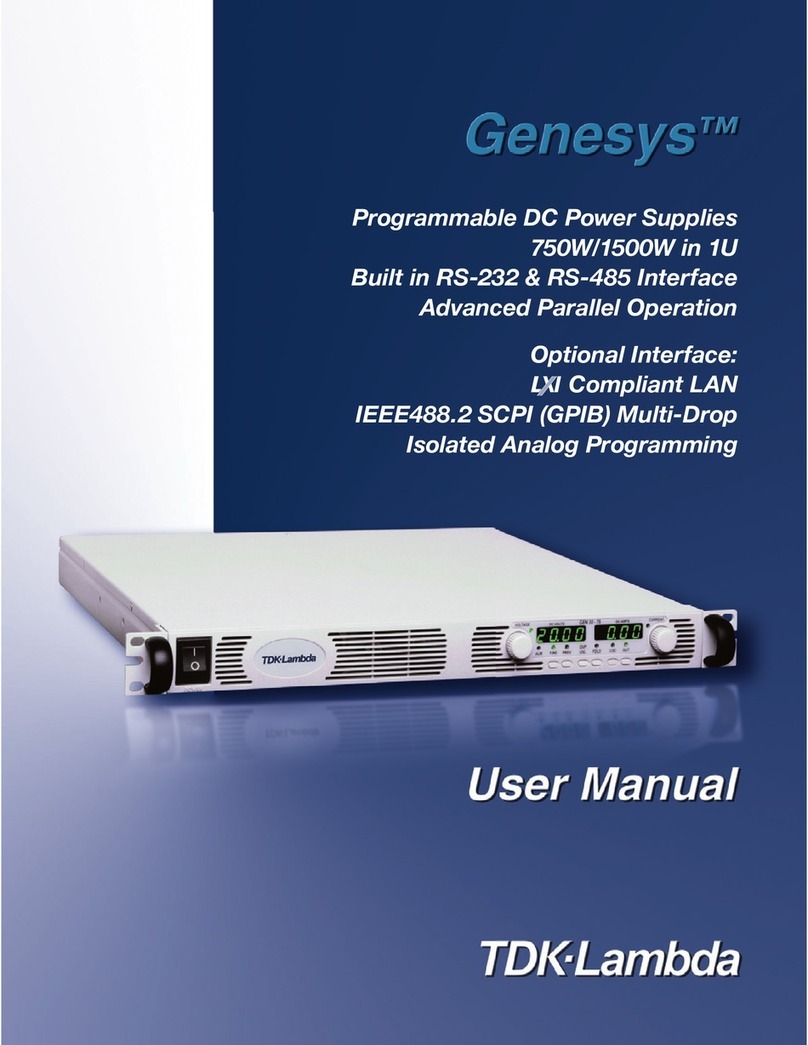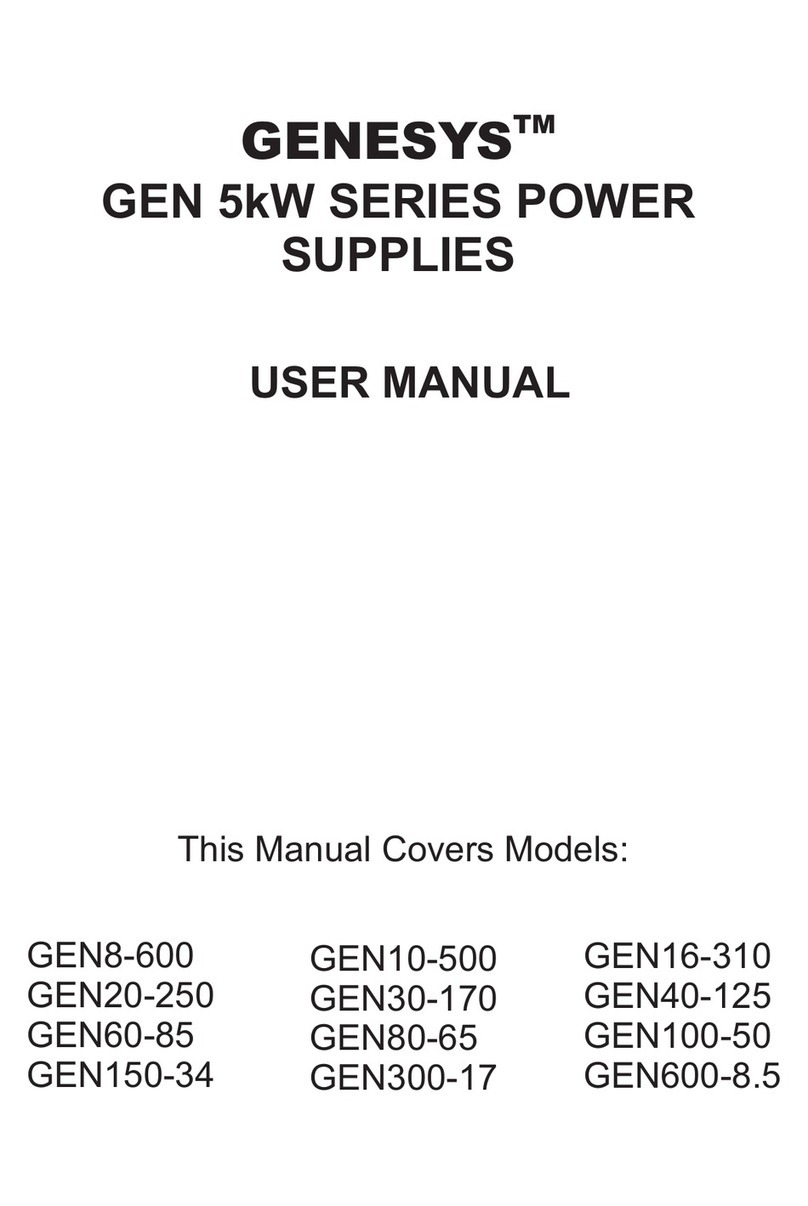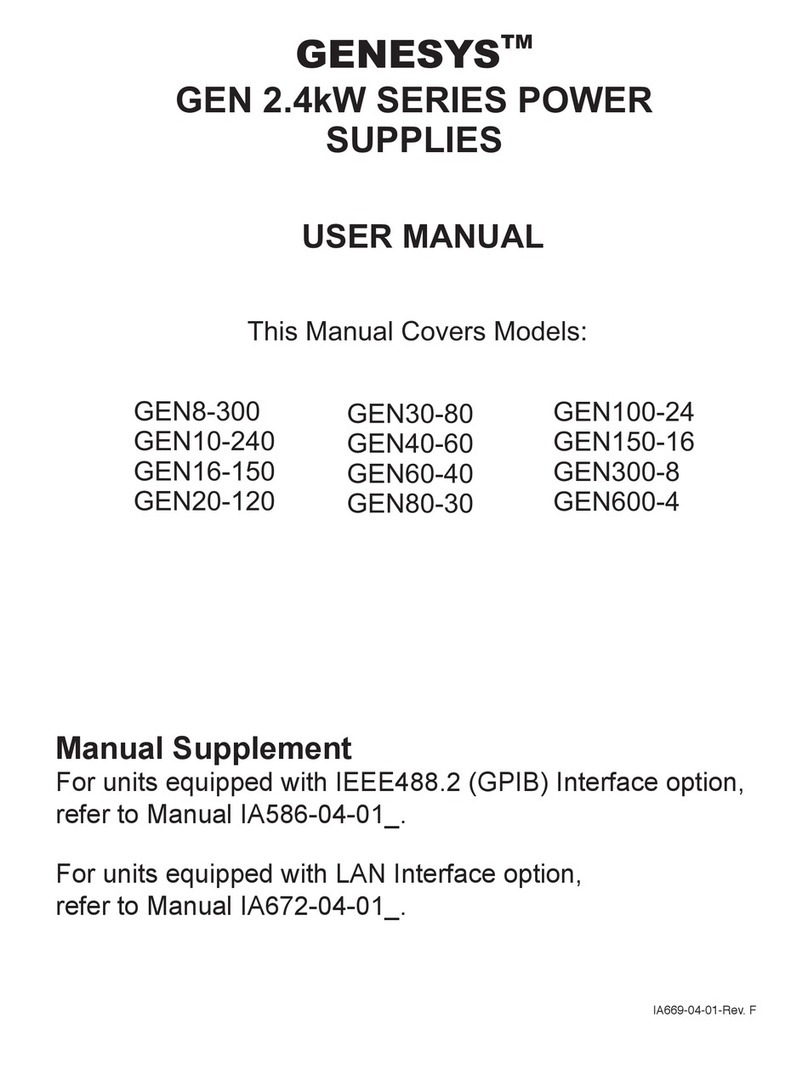CHAPTER 6 REMOTE ANALOG PROGRAMMING
CHAPTER 7 RS232 & RS485 REMOTE CONTROL
CHAPTER 8 ISOLATED ANALOG PROGRAMMING OPTION
CHAPTER 9 MAINTENANCE
.................................................................
6.1 INTRODUCTION ...........................................................................................................................
6.2 LOCAL/REMOTE ANALOG CONTROLL.......................................................................................
6.3 LOCAL/REMOTE ANALOG INDICATION......................................................................................
6.4 REMOTE VOLTAGE PROGRAMMING OF OUTPUT VOLTAGE AND CURRENT LIMIT .............
6.5 RESISTIVE PROGRAMMING OF OUTPUT VOLTAGE AND CURRENT LIMIT ...........................
6.6 REMOTE MONITORING OF OUTPUT VOLTAGE AND CURRENT .............................................
...............................................................
7.1 INTRODUCTION ...........................................................................................................................
7.2 CONFIGURATION .........................................................................................................................
7.2.1 Default setting .......................................................................................................................
7.2.2 Address setting .....................................................................................................................
7.2.3 RS232 or RS485 selection ...................................................................................................
7.2.4 Baud rate setting ...................................................................................................................
7.2.5 Setting the unit into Remote or Local mode ..........................................................................
7.2.6 RS232/458 port at Local mode .............................................................................................
7.2.7 Front panel in Remote mode ................................................................................................
7.3 REAR PANEL RS232/485 CONNECTOR ......................................................................................
7.4 CONNECTING POWER SUPPLIES TO RS232 OR RS485 BUS .................................................
7.4.1 Single power supply ..............................................................................................................
7.4.2 Multi power supplies connection to RS232 or RS485 bus ....................................................
7.5 COMMUNICATION INTERFACE PROTOCOL ..............................................................................
7.5.1 Data format ...........................................................................................................................
7.5.2 Addressing ............................................................................................................................
7.5.3 End of message ....................................................................................................................
7.5.4 Command repeat .................................................................................................................
7.5.5 Checksum .............................................................................................................................
7.5.6 Acknowledge .........................................................................................................................
7.5.7 Error message ......................................................................................................................
7.5.8 Backspace ............................................................................................................................
7.6 ERROR MESSAGES .....................................................................................................................
7.7 COMMAND SET DESCRIPTION ..................................................................................................
7.7.1 General guides .....................................................................................................................
7.7.2 Command set categories ......................................................................................................
7.7.3 Initialization control commands .............................................................................................
7.7.4 ID control commands ............................................................................................................
7.7.5 Output control commands .....................................................................................................
7.7.6 Global output commands.......................................................................................................
7.7.7 Status control commands .....................................................................................................
7.8 STATUS, ERROR AND SRQ REGISTERS ...................................................................................
7.8.1 General .................................................................................................................................
7.8.2 Conditional registers .............................................................................................................
7.8.3 Service Request: Enabled and Event Registers ...................................................................
7.9 SERIAL COMMUNICATION TEST SET-UP ..................................................................................
..............................................
8.1 INTRODUCTION ...........................................................................................................................
8.2 SPECIFICATIONS .........................................................................................................................
8.2.1 0-5V/0-10V option .................................................................................................................
8.2.2 4-20mA option .......................................................................................................................
8.3 ISOLATED PROGRAMMING & MONITORING CONNECTOR ....................................................
8.4 SETUP AND OPERATING INSTRUCTIONS .................................................................................
8.4.1 Setting up the power supply for 0-5/0-10V Isolated Programming and Monitoring ...............
8.4.2 Setting up the power supply for 4-20mA Isolated Programming and Monitoring ..................
......................................................................................................
9.1 INTRODUCTION ...........................................................................................................................
9.2 UNITS UNDER WARRANTY .........................................................................................................
9.3 PERIODIC MAINTENANCE ..........................................................................................................
9.4 ADJUSTMENT AND CALIBRATION .............................................................................................
9.5 PARTS REPLACEMENT AND REPAIRS .......................................................................................
9.6 TROUBLESHOOTING ...................................................................................................................
9.7 FUSE RATING ...............................................................................................................................
USER MANUAL INDEX .......................................................................................................................
TABLE OF CONTENTS
Pg.44
Pg.44
Pg.44
Pg.44
Pg.45
Pg.46
Pg.47
Pg.48
Pg.48
Pg.48
Pg.48
Pg.48
Pg.48
Pg.48
Pg.48
Pg.49
Pg.49
Pg.49
Pg.50
Pg.50
Pg.51
Pg.51
Pg.51
Pg.51
Pg.51
Pg.51
Pg.51
Pg.51
Pg.52
Pg.52
Pg.52
Pg.52
Pg.52
Pg.52
Pg.53
Pg.53
Pg.53
Pg.55
Pg.56
Pg.57
Pg.57
Pg.57
Pg.58
Pg.61
Pg.62
Pg.62
Pg.62
Pg.62
Pg.62
Pg.63
Pg.64
Pg.64
Pg.64
Pg.65
Pg.65
Pg.65
Pg.65
Pg.65
Pg.65
Pg.65
Pg.66
Pg.67






























